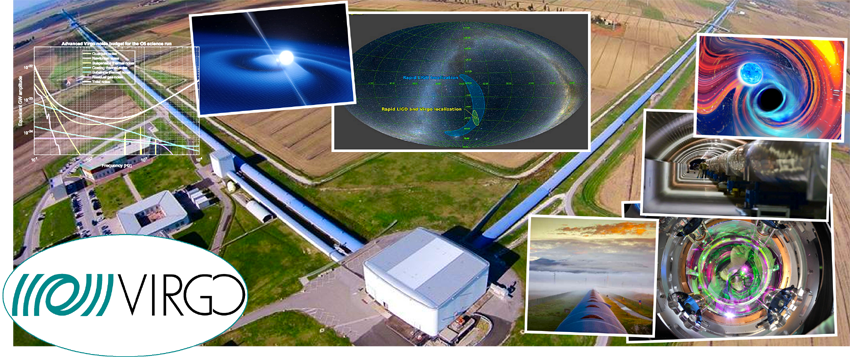
Virgo, accomplished 200 candidate gravitational wave events in last observing period.
Virgo is one of the three, highest sensitiviy, ground-based laser interferometers for the detection of gravitational waves (GW). Located in Cascina (Pisa, Italy), at the site European Gravitational Observatory (EGO) site, is the result of an Italian-French initiative led by INFN and CNRS, currently operated by an international scientific collaboration of more than 20 nations, including France, Italy, the Netherlands, Belgium, Poland, Spain, Hungary and Germany.
GW, predicted by General Relativity, are ripples, undulations, in the space-time continuum propagating at the speed of light, and generated by different astrophysical sources: inspiraling and merging binary systems consisting of massive black holes or compact objects (black holes or neutron stars), pulsars and supernova explosions. They may also be of cosmological origin. The detection and study of GW allow us a deeper understanding of gravity-related phenomena, even under strong field conditions, and the investigation of matter’s physics at extreme (supranuclear) densities.
The first GW signal, discovered in 2015 and produced by inspiraling and merging of two black holes, with masses 35.4 and 29.8 times that of our Sun (GW150914), was awarded with the 2017 Nobel Prize in Physics. The Virgo and LIGO (with its two interferometers in the USA) Collaborations also received the Breakthrough Prize in Fundamental Physics and the Gruber Cosmology Prize in 2016, and the Einstein Medal in 2017. In 2017, Advanced Virgo and the two Advanced LIGOs measured the first gravitational signal emitted by the merger of two neutron stars (GW170817), detected in temporal-spatial coincidence with a short gamma-ray burst (GRB), the GRB 170817A, by the Fermi gamma-ray space telescope, followed-up by other satellites and ground-based observatories across the electromagnetic spectrum. This marked the birth of multi-messenger astrophysics with GWs.
The first two observing periods (O1 and O2) were followed by a third round of data taking, with the full network of LIGO-Virgo-KAGRA interferometers (LVK, O3). During O3, 90 GW events are detected, where a significant number are mergers of two black holes, as well as mergers of two neutron stars and mixed black hole-neutron star systems. The Gravitational-wave Transient Catalog (GWTC, data release 3) is the most up-to-date cumulative database of confirmed GW transients from the LVK collaboration. The fourth observing cycle (O4), which began in May 2023, is scheduled to end in November 2025 and contain, already, more than 200 candidate GW events. The observing time percentage of Virgo, about 80%, is the highest in the LVK network. The addition of Virgo’s data to LIGO’s triggers have substantially improved the sky localization of the detected GW events.
The local INFN Rome Tor Vergata group of Virgo is working on key aspects, such as adaptive optics to measure and correct optical aberrations, the reduction of thermal noise in mirrors using multilayer coatings on optical surfaces made of innovative materials, and the reduction of quantum noise. The group has important responsibilities in construction and developments for the next observing period (O5). It is also active, in the analysis of data collected in the current observing campaign, particular, in multi-messenger analysis of gravitational signals coincident with high-energy GRBs.
























































































